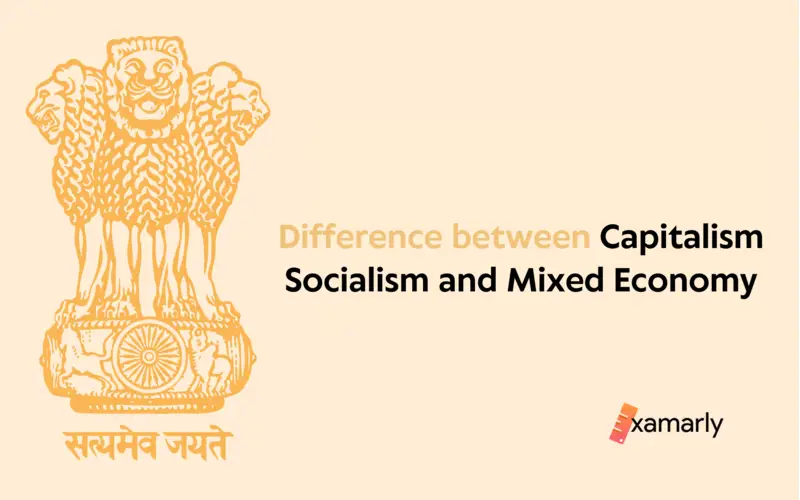An Overview
In this article, we will not only cover the difference between capitalism socialism and mixed economy but will also cover all these concepts exclusively explicitly.
This article will reflect on all the important aspects of certain types of Economy and the value they add to the country’s financial health.
Let us dive deep into the article in detail and unravel all the concepts covered in it.
- An Overview
- What is the Economy of the country?
- What is a Capitalist Economic System?
- What is a Socialist Economic System?
- What is a Mixed Economic System?
- Differences Between Socialist, Mixed and Capitalist Economy
- Summing Up
- FAQs
- What is a capitalist economy?
- What is a socialist economy?
- What is a mixed economy?
- How do capitalist and socialist economies differ?
- What are the advantages of a capitalist economy?
- What are the disadvantages of a capitalist economy?
- What are the advantages of a socialist economy?
- What are the disadvantages of a socialist economy?
- How does a mixed economy balance the advantages and disadvantages of capitalist and socialist economies?
- What role does government play in a capitalist economy?
- What role does government play in a socialist economy?
- What role does government play in a mixed economy?
- How does the distribution of wealth differ in capitalist and socialist economies?
- Can a capitalist economy coexist with socialist policies?
- Can a socialist economy coexist with capitalist policies?
What is the Economy of the country?
An economy of a country refers to the system of production, distribution, and consumption of goods and services in that country.
It includes the factors of production such as land, labour, capital, and entrepreneurship, and it also includes the institutions and markets that govern the allocation of resources.
The economy of a country can be measured by various indicators such as gross domestic product (GDP), unemployment rate, and inflation rate.
What is a Capitalist Economic System?
Capitalism is an economic system characterized by private ownership of the means of production and the creation of goods and services for profit.
The driving force of capitalism is the pursuit of profit through the accumulation of capital, which is invested in the production of goods and services.
Under capitalism, the market is driven by supply and demand, and prices are determined by competition.
Features Of Capitalism
One of the key features of capitalism is the separation of ownership and control. In a capitalist economy, individuals and businesses own the means of production, such as factories, land, and resources, but they do not necessarily control them. Instead, they may hire managers to operate the business and workers to produce goods and services.
Capitalism is known for its efficiency in allocating resources, as it encourages businesses to produce what consumers want and to find the most efficient ways of producing it.
The invisible hand of the market is supposed to guide resources to their most productive use. Innovation is also encouraged, as businesses seek new ways to cut costs and produce goods and services more efficiently.
Some Drawbacks Of Capitalism
However, capitalism also has its drawbacks. One of the most significant criticisms is that it can lead to significant economic inequality, as those who own the means of production tend to accumulate wealth at a faster rate than those who do not.
It can also lead to instability in the economy, as businesses can fail and unemployment can rise during economic downturns.
Capitalism is often criticized for its negative impact on the environment, as the pursuit of profit can lead to the depletion of natural resources and pollution.
It is also criticized for lacking a safety net for those who are unable to participate in the market, such as the elderly, disabled, or unemployed.
In capitalist systems, government plays a minimal role in the economy, mainly in the form of regulations to protect consumers and maintain competition.
The government’s role is to create and maintain a legal and regulatory framework that allows businesses to operate freely, but also to protect the rights of consumers and workers.
Overall, capitalism is a complex economic system that has its benefits and drawbacks. It is up to society to find the balance between economic growth and social welfare.
What is a Socialist Economic System?
A socialist economic system is one in which the means of production, such as factories and land, are collectively owned and controlled by the community or government.
The goal of socialism is to eliminate social and economic inequality by redistributing wealth and resources. In theory, this should create a more equitable society in which all individuals have equal access to the necessities of life.
In practice, socialist systems have taken many different forms. Some countries, such as the Soviet Union and China, have implemented state-controlled economies in which the government owns and manages all property and resources.
Other countries, such as Sweden and Denmark, have implemented more moderate forms of socialism in which the government plays a larger role in providing social services and regulating the economy, but private ownership and free market principles still play a significant role.
Some Drawbacks
One of the main criticisms of socialist systems is that they can lead to inefficiencies and a lack of innovation, as the government controls the economy and there is less incentive for individuals to work hard and be productive.
Additionally, there have been instances where socialist governments have abused their power and violated human rights.
On the other hand, proponents of socialism argue that it is a more fair and equitable economic system that prioritizes the needs of the community over the profit motive.
They also argue that socialism can lead to a more efficient allocation of resources, as the government can make decisions based on what is best for society as a whole, rather than what is most profitable.
Overall, the economic system of socialism is a complex and nuanced topic, with both advantages and disadvantages.
It is important to note that no country has fully implemented a socialist economic system and those that claim to have done so have varied and evolved over time.
What is a Mixed Economic System?
A mixed economic system is one that combines elements of both capitalist and socialist economic systems. In a mixed economy, there is a balance between private enterprise and government intervention.
Private businesses and individuals are allowed to own and operate companies and make a profit, but the government also plays a role in regulating the economy and redistributing wealth.
Some Characteristic Features Of a Mixed Economic System
The specific characteristics of a mixed economy can vary depending on the country and its government policies. However, some common features include:
- Private property rights: Individuals and businesses are allowed to own and operate companies, and the government generally does not nationalize industries.
- Market-based prices: Prices for goods and services are determined by supply and demand in the marketplace.
- Government intervention: The government can intervene in the economy to achieve certain goals, such as promoting economic growth, reducing poverty, or protecting the environment. This can take the form of regulations, taxes, subsidies, or public goods and services.
- Redistribution of wealth: The government can use progressive taxation and social welfare programs to redistribute wealth and reduce income inequality.
Some Advantages
One of the main advantages of a mixed economy is that it can achieve a balance between economic growth and social welfare.
Private enterprise and market competition can lead to innovation and efficiency. At the same time, government intervention can ensure that everyone has access to the necessities of life and that the economy serves the needs of the whole society.
Some Drawbacks
Critics of mixed economies argue that government intervention can lead to inefficiencies, high taxes, and a lack of incentive for individuals to work hard and be productive.
They also argue that redistributive policies can discourage work and investment, and create a culture of dependency on government assistance.
Proponents of mixed economies argue that it is a more balanced and realistic approach to economic management that takes into account the strengths and weaknesses of both capitalism and socialism.
They also argue that mixed economies have led to higher standards of living and more stable economic growth.
Overall, mixed economic systems are characterized by a balance of private enterprise and government intervention, with a focus on promoting economic growth and social welfare.
It is also important to note that different countries have different degrees of intervention, and the balance between private enterprise and government intervention can vary.
You Might Also Like – Capitalism Vs Socialism Vs Communism
Differences Between Socialist, Mixed and Capitalist Economy
| Economic System | Ownership of Production | Role of Government | Distribution of Wealth | Pricing and Market Forces |
|---|---|---|---|---|
| Socialist | Collective/Government | Heavy Regulation | Equality | Limited/Planned |
| Mixed | Private/Public | Moderate Regulation | Some Equality | Mixed |
| Capitalist | Private | Limited Regulation | Wide Inequality | Market-Driven |
Here is a table that summarizes the main differences between socialist, mixed, and capitalist economic systems.
- In socialist systems, the means of production are owned collectively or by the government, and there is heavy regulation by the government. The goal is to achieve equality in the distribution of wealth. Pricing and market forces are limited or planned.
- In mixed systems, ownership of production can be a combination of private and public, and government regulation is moderate. The goal is to achieve some level of equality in the distribution of wealth. Pricing and market forces are mixed.
- In capitalist systems, the means of production are owned privately, and government regulation is limited. The distribution of wealth is characterized by wide inequality, and pricing and market forces are market-driven.
Summing Up
In summary, the main differences between socialist, mixed, and capitalist economic systems are the ownership of production, the role of government, the distribution of wealth, and the influence of pricing and market forces.
In a socialist economy, the means of production are owned collectively or by the government, and there is heavy government regulation.
The goal is to achieve equality in the distribution of wealth, and pricing and market forces are limited or planned.
In a mixed economy, ownership of production can be a combination of private and public, and government regulation is moderate.
The goal is to achieve some level of equality in the distribution of wealth, and pricing and market forces are mixed.
In a capitalist economy, the means of production are owned privately and government regulation is limited. The distribution of wealth is characterized by wide inequality and pricing and market forces are market-driven.
FAQs
What is a capitalist economy?
A capitalist economy is an economic system in which private individuals and businesses own the means of production and operate for profit.
What is a socialist economy?
A socialist economy is an economic system in which the means of production are owned and controlled collectively by society, often through the government.
What is a mixed economy?
A mixed economy is an economic system that combines elements of capitalism and socialism, typically with a dominant focus on private enterprise and a regulated market.
How do capitalist and socialist economies differ?
Capitalist economies prioritize individual ownership and the profit motive, while socialist economies prioritize collective ownership and the goal of meeting the needs of all citizens.
What are the advantages of a capitalist economy?
Some of the advantages of a capitalist economy are that it can create wealth, innovation, and economic growth.
What are the disadvantages of a capitalist economy?
Some of the disadvantages of a capitalist economy are that it can lead to income inequality, a lack of access to basic necessities for some citizens, and instability in the business cycle.
What are the advantages of a socialist economy?
Some of the advantages of a socialist economy are that it can promote greater income equality, access to basic necessities for all citizens, and stability in the business cycle.
What are the disadvantages of a socialist economy?
Some of the disadvantages of a socialist economy are that it can lead to a lack of incentive to work, slow economic growth, and a lack of innovation.
How does a mixed economy balance the advantages and disadvantages of capitalist and socialist economies?
A mixed economy attempts to balance the advantages and disadvantages of capitalist and socialist economies by allowing for private enterprise and individual ownership while also implementing government regulations and social welfare programs.
What role does government play in a capitalist economy?
In a capitalist economy, the role of government is generally limited to enforcing property rights and contracts, as well as providing public goods and services.
What role does government play in a socialist economy?
In a socialist economy, the government plays a larger role in the economy, often owning and controlling key industries, and making decisions about the distribution of resources.
What role does government play in a mixed economy?
In a mixed economy, the government plays a role in regulating the economy and ensuring that market outcomes are consistent with the overall welfare of society.
How does the distribution of wealth differ in capitalist and socialist economies?
In capitalist economies, wealth is distributed according to market forces, which can result in a large gap between the wealthy and the poor. In socialist economies, wealth is distributed more evenly through government policies aimed at reducing income inequality.
Can a capitalist economy coexist with socialist policies?
Yes, a capitalist economy can coexist with socialist policies, such as progressive taxation, social welfare programs, and government-provided healthcare.
Can a socialist economy coexist with capitalist policies?
Yes, a socialist economy can coexist with capitalist policies, such as private property rights and a limited role for the market in certain industries.






